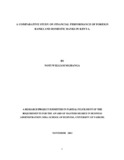| dc.description.abstract | This study is to ascertain whether the performance of foreign banks is different from their
domestic counterparts over the period 2006 to 2010.The units of analysis are all commercial
banks in Kenya. The data used in this study is from Central bank of Kenya and web sites and
from the annual financial statements for 43 licensed commercial banks in Kenya for a period
of five years. This allows for use of annual data that is largely secondary data.
This study is an investigation into the discrimination between domestic and foreign banks, by
the use of five performance and risk discriminating variables. The statistical data was
gathered for their five characteristics, return on assets (ROA), return on equity (ROE),
liquidity, capital adequacy and credit risk for each bank that represent independent variables.
The dependent variable is categorical, foreign bank or local bank. These are examined for the
capability to discriminate significantly between foreign and domestic banks. Therefore, the
appropriate tool for analysis used is the discriminant technique. The test to be done under
discriminant analysis depends on the number of groups and number of variables. In this study
are two groups and several (5) variables and the relevant test is Hotel ling’s T2.
Significant mean differences were observed for the predictors, except on capital adequacy.
The log determinants were quite similar, and Box’s M indicated that the assumption of
equality of covariance matrices was not violated. The discriminate function revealed a
significant association between groups and predictors variables, accounting for 27.9% of
between group variability. Three ROA, ROE and credit risk are significant predictors. The
cross validated classification showed that overall 73.6% were correctly classified confirming
significant differences in risk and return characteristics between foreign and commercial
banks in Kenya. The descriptive statistics confirm that foreign banks earn superior returns
when compared to domestic banks and also exhibit low credit risk.
The credit risk management approaches of domestic banks and foreign commercial banks are
different, and one can argue that, this is the source of difference in performance across the
commercial banks. It might be that foreign banks deploy superior management techniques.
Liquidity and capital adequacy is not useful in discriminating foreign and domestic banks.
This is attributed to monitoring of capital adequacy levels set by Central Bank of Kenya. | en_US |



